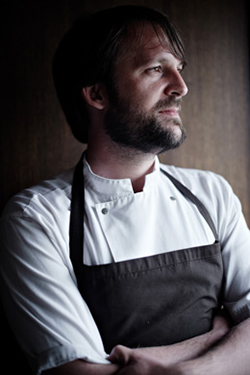Few consider the faith of the food writer. And this is probably a good thing. I won’t say that to worship food and drink is to pray to a false god. But even with all the high-minded talk of farm-to-table or Slow Food movements, of molecular gastronomy or urban gardening, of locavorism or fruitarianism or whatever-the-latest-ism, in my experience it rarely leads one down the shining path of enlightenment.
Or at least that’s what I believed until this past spring, when I spent one of the most glorious weeks of my life eating my way through Copenhagen, capped off by a 25-course, five-hour lunch at Noma, considered by many to be the best — and most thought-provoking — restaurant in the world.
“Some people see going to Noma as a religious experience,” said Michael Bom Frøst, a food scientist and director of the nonprofit Nordic Food Lab, which was established by Noma’s owners. This was several days before my own meal at Noma, and we stood in the lab’s shiny test kitchen, inside a houseboat moored across the canal from Noma. The brilliant Nordic sun shone in the bluest Nordic sky as we ate a pink ice cream made from seaweed and looked across the cold water toward Copenhagen’s center.
Copenhagen, as all who worship food and drink know, has become the epicenter of the “New Nordic” cuisine, which has supplanted Spain’s formerly avant-garde molecular gastronomy as the latest, buzzy Big Idea in international cuisine.
“High-level chefs change the world in ways that are unprecedented,” Frøst said. “They change the way we view food.”
In this case, he was talking about René Redzepi, Noma’s chef and the high priest of the New Nordic cuisine. The 34-year-old Redzepi had done stints early in his career at the late El Bulli near Barcelona (then still considered the best restaurant in world) and the French Laundry in Napa Valley before returning to Copenhagen to work at the fancy Kong Hans Kælder. In 2003, restaurateur Claus Meyer tapped Redzepi to open Noma in an 18th-century warehouse. Fast forward less than a decade. In April, Time magazine listed Redzepi as one of “The 100 Most Influential People in the World.”
Around the time of Noma’s opening, Redzepi and Meyer, along with other young chefs, drafted a New Nordic cuisine manifesto (because you simply can’t have a movement without a manifesto). They called for, among other things, “purity, freshness, simplicity, and ethics,” much like an earlier influential Danish artistic movement with a manifesto, the Dogme 95 film movement led by Lars von Trier. The New Nordic chefs promoted the sole use of seasonal, Scandinavian ingredients — which meant, for instance, no olive oil, no lemons and no pasta — and a return to traditional Scandinavian techniques such as pickling, smoking, curing and fermenting. The idea was to force creativity by setting limitations.
Here’s how New Nordic cuisine came to be identified: Ingredients such as sea-buckthorn or Douglas fir or gooseberries or deep-fried moss; cellared or slow-cooked vegetables and under-ripe fruit; dishes served on pieces of wood, rocks, seashells and tree branches; a focus on fish and veggies, rather than meat. Dishes, plated with wild grasses and leaves and such, mimic nature, with a fashionably mussed-up aesthetic, compared with the geometric, architectural plates of molecular gastronomy.
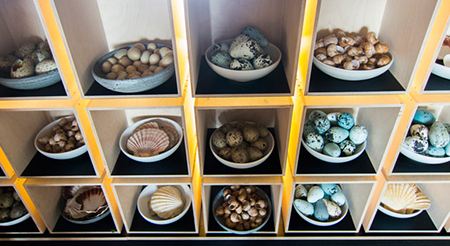
Then, of course, there’s the whole foraging thing. The popular practice of U.S. chefs’ searching for wild herbs and greens is a direct influence of the New Nordic cuisine. And the topic has proved irresistible to food writers, so many of whom wrote stories about foraging with Noma’s chef that Eater.com called out the journalistic trend as the “I Foraged With René Redzepi Piece.”
Of course, with any buzz there is skepticism and backlash. For example, Time magazine columnist Josh Ozersky called Redzepi the “personification of nature worship,” which Ozersky snarkily described as “an ardent belief system among top-tier chefs that seems to skirt the distinction between gastronomy and religion.”
I thought about the distinction between gastronomy and religion as I ate my pink seaweed ice cream on the Nordic Food Lab’s houseboat and talked to Lars Williams, the research and development chef. (Williams has the opening lines of Milton’s “Paradise Lost” tattooed on his arm.)
“We’re designing the building blocks of food here. We’re trying to produce more letters to the culinary alphabet,” Williams said. “For instance, we’re trying to inspire people to use seaweed as a food resource. But we don’t want to force a concept that’s foreign to them.” Thus, the ice cream.
“Seaweed is beautiful,” he added. “But most people only see it rotten and smelly on the beach. Well, if you were walking in an apple orchard and you only saw rotten apples on the ground, you wouldn’t have a good opinion of apples, either.”
This sort of thinking, and these sorts of experiments, are at the heart of Redzepi and Meyer’s Nordic Food Lab. The nonprofit studies uses for overlooked or unappreciated local products — foodstuffs people might formerly have considered “weeds” or “trash fish” or “scraps.”
“Right now, we’re looking at insects,” Williams said. “Why are insects not part of the European diet?”
Williams fed me some insects, which, were crunchy and harmless, and which I could see providing texture to the dish. He served me a “vintage carrot,” one that had remained long in the ground, that had then been slow cooked to the consistency of meat. We tasted dried kelp, dried woodruff, and coarum, a fish sauce dating from Roman times made from the discards of fish heads and tails and guts. He also fed me a bright carrot juice vinegar that had been fermenting with the same frightening bacteria used in the starter for kombucha tea. “In Scandinavia, vinegars are a traditional way of seasoning food,” he said.
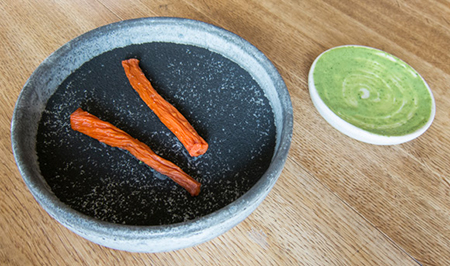
“Now, I’m going to serve you a little bit of moldy barley,” Williams said. “This is something we’re very excited about.” Into a sizzling frying pan, Williams plopped a slab of barley that had been soaked and steamed and allowed to mold over a couple days.
After a few minutes, he handed it to me on a plate, and I dutifully chewed.
“What do you think this tastes like?” he asked.
“It’s got the consistency of pork belly, doesn’t it?” I said.
“Yes, exactly,” Williams said.
“You see,” Frøst said, “if you want people to appreciate the new, it must possess novelty, but it also has to have familiarity.”
“Well, anyway, this is pretty delicious,” I said. And I wasn’t lying.
I ate my porridge along with my friend Trine Skjøldberg, who breastfed her newborn while her 3-year-old colored, at a hip subterranean porridge bar called Grød, on Jægersborggade near the Assistens Kirkegård, a lovely, leafy cemetery where Søren Kierkegaard and Hans Christian Andersen are buried and where people hang out on blankets on a sunny day. Jægersborggade is one of the hippest streets in Norrebrø, the “SoHo of Copenhagen,” with shops and coffeehouses and beautiful young Danes oozing cool. The interesting thing about “hip” here is that it’s always cozy, with candles on the wooden tables, solid warm colors on the walls and bicycles parked out front.
There’s a lovely and pretty much untranslatable concept in Danish called “hygge.” Words such as “cozy,” “snug” or “feel-good” approach the meaning. An occasion that evokes hygge will be generous, familiar, unchallenging and happy. Friends will raise toasts, most likely over candlelight or an open fire. It’s this attitude that I love most about Denmark and my Danish friends, and it’s what makes even a big city such as Copenhagen feel like home.
Long before the advent of the New Nordic cuisine, I’d spent time in Copenhagen over the years. Regularly named the “happiest country in the world” Denmark has always been on my short list of dream countries to live in. Still, the eating had long been sort of a yawn. A decade ago, the idea that Copenhagen (or anywhere in Scandinavia) would become the world’s trendiest food city seemed patently absurd. I mean, it was certainly nice to eat smorrebrød (otherwise known as open-faced sandwiches) and wienerbrød pastries (don’t call them “danish”) and drink aquavit, but the city wasn’t exactly a culinary tour de force.
That started changing in the 2000s. It wasn’t just the success of Noma, which prompted a domino effect of chefs opening “New Nordic” restaurants. The nation itself began to take food seriously. In 2004, Denmark was the first country to institute a trans fat ban. In 2011, it became the first country to levy a “fat tax” on saturated fat and is considering adding a tax on sugar in 2013. Denmark consumes the most organic products per capita in the world. Researchers at the University of Copenhagen have concluded that the New Nordic diet is as healthful as the famed Mediterranean diet.
This concept of hygge has not been lost during Copenhagen’s emergence as a culinary center. A quote from Redzepi’s 2010 book “Noma: Time and Place in Nordic Cuisine” is noteworthy: “I suddenly had the feeling that most Scandinavians recognized something in our food — something from their childhood. Everyone has tried walking around a lake, where the dead leaves crunch under your feet — or at any rate they have visited a farm. A visit to Noma should reflect those experiences, and many Scandinavians have told me that a meal in our restaurant reminded them of something lying hidden way back in their memory.”
Then, important for me, Redzepi also writes about the experience of foreigners who first eat his New Nordic cuisine: “They had an experience they couldn’t get at home. Several have said it was like hearing a new language and being able to understand what was being said.” This is what Copenhagen has always been like for me, like a song I know by heart and don’t really know why.
“Faith is the highest passion in a human being. Many in every generation may not come that far, but none comes further.” So wrote Kierkegaard, Copenhagen’s brooding existentialist, many years ago. It certainly took some odd faith — or insanity — for me to wake up at 3 a.m. on the sixth of the month, three months earlier, to be ready when Noma opened its phone and Internet reservation services. Thousands of people jockey to get these reservations each month, and I had two laptops open, the browsers of which I refreshed about 900 times, meanwhile dialing and redialing the restaurant on my phone about 50 times.
Miraculously, my faith was rewarded. And here we were. On the last day of my trip, Trine and I arrived at 11:45 for our noon lunch reservation at Noma.
As soon as we settled into our fur seats, next to the sunny view of the harbor, the waiter said, “Your first dish is the branches in here,” pointing to the flower vase on the table. The crunchy branches were juniper-crusted malt flatbreads. Almost immediately, deep-fried moss — “what the reindeer survive on” — was brought to the table. How to describe the delicately crisp wisps of moss that we dipped in crème fraiche? “This moss actually reminds me of the trees on my father’s train sets,” Trine said.
Over the next hour, a rapid-fire succession of 15 snacks came at us: Crispy pigskin in a leather made of black currant; blue mussels in a “shell” made from a squid ink cracker; a tray of cookies made from two rare cheeses from Sweden; pickled quail eggs smoked over hay; carrots that had been cooked at low temperature for hours, served over black hay ash and sorrel sauce; frozen cod liver that was sliced thin, which we were told “has to be eaten immediately because it’s melting”; traditional Danish æbleskiver, a sort of spherical pancake, fried in bone marrow, whimsically stuffed with a small freshwater fish from Finland and a pickled cucumber; and Noma’s famous radishes and carrots served in a pot of “dirt” made from malt and hazelnut flour.
The nonstop siege of these familiar-but-totally-strange tastes had the immediate effect of destabilizing our palates and making me rethink my preconceptions of what food can be.
Then the real meal began: Langoustines, served on a rock, which you dragged through seaweed powder and oyster sauce; caramelized cauliflower covered with evergreen branches and served with whey, pine oil, and horseradish crème fraiche; grilled pike topped with foam made from the fish’s bones that tasted like essence of a spring lake; razor clam rolled in parsley gel and served with horseradish and buttermilk powder.
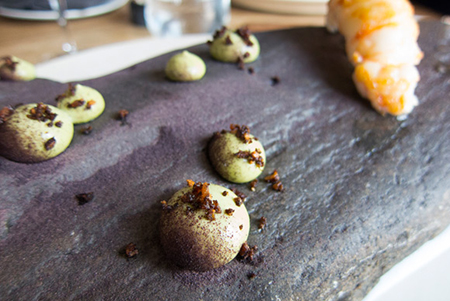
The only non-Nordic part of the meal was the wine pairing, though it still had a northern flair — white wines from Germany and Austria and France’s Loire Valley. Trine, however, went with a juice pairing that included various tastes of cucumber-dill, carrot-juniper berry, beetroot-lingonberry, and pear-verbena.
I have been friends with Trine, a Danish photographer, since we met in Iceland in the 1990s. A fond image I have of her is carrying around a guidebook of Nordic mushrooms to forage in the glacial Icelandic meadows. As a child, she had attended an outdoor “forest kindergarten,” so I wasn’t surprised that certain ingredients brought back memories. One in particular was the oxalis, or wood-sorrel, that topped a beautiful rainbow assortment of pickled vegetables, with dollops of bone marrow, and pork-white wine reduction. “This was my favorite thing to eat in forest kindergarten,” she said.
A dish of raw Danish squid served with unripe sloe berries and pickled Douglas fir, for me, brought to mind December nights outdoors of selling Christmas trees with my brothers. For Trine, it was a little different: “This reminds me of this one time when I went to a techno party in the woods, and I took so many drugs that I tried to eat a pine tree.”
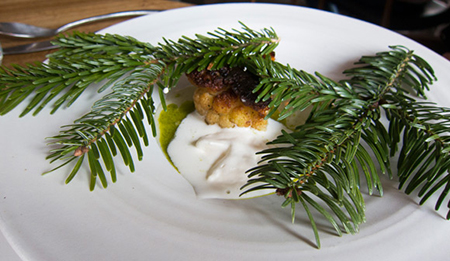
The final, showstopper dish was a whole roasted turbot, so fat at this time of year from being full of roe that it had the texture of beef, served in a sauce of dried mushrooms and berries, and garnished with a collection of foraged greens. Trine and I couldn’t identify one of them and asked the waiter, who said it was ground elder. “It’s like one of the worst weeds. It’s weed you definitely don’t want in your garden,” the waiter said. “Better to eat it in your dish at Noma.”
Redzepi himself made an appearance at our table, early in the meal, bringing us two wiggling shrimp on ice, which we were told to pop into our mouths live. Trine’s flopped out of her hand onto the plate before she finally subdued it, but Redzepi delivered his sermon on time and place in Nordic cuisine without missing a beat: “The tastes of these shrimp changes from day to day, depending on the conditions of the ocean. Eating them is really like tasting the ocean on that day.”
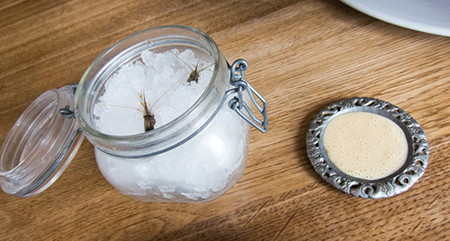
In fact, each plate was served by a chef from the kitchen — at any given time, there are more than 40 chefs from around the world working for about 35 patrons in the dining room. Among the international cast, I was happy to see Daniel Giusti turn up at our table with a plate. Giusti was the chef at 1789 in Washington, D.C., for three years. But he, like many of the chefs, was drawn to Noma for the chance to work for Redzepi.
“I wanted to see the thought process behind this place,” Guisti had told me the day before over coffee at Coffee Collective (which many consider to be the finest coffee roaster in the world). “The flavors at Noma are intense. They’re not for everyone. There’s an aura about this restaurant that I’ve never seen before. René can do anything he wants.”
For instance, during our lunch, we saw that Redzepi can serve 15 snacks and 10 courses without one plate you could really call a “meat” dish. And he could pair these dishes with not one red wine. And he can charge $400 per person to experience this, and people — including me — will gladly pay it.
Before I left Copenhagen, I had a long Sunday lunch with another friend, Mette, at the trendy restaurant Radio — part of the growing empire of Claus Meyer, Rezepi’s partner, which includes the ubiquitous Meyers Deli chain.
Our first course was, interestingly enough, Danish squid with beetroot and unripe elderberries. “Danish squid is very trendy,” Mette told me. “They serve it everywhere. But before? Nobody ate it.”
“When is beetroot season?” I asked. “I’ve eaten a lot of beetroot this week.”
“It’s always beetroot season,” she said.
I met Mette about 10 years ago at a hazy music festival in the hippy-tastic “Freetown” of Christiania, an 80-acre section of the city — only a few minutes walk from Noma — that once was a military fortress and now is home to squatters who started their own community. Despite the government’s threats to “normalize” the area, they still sell hash on Christiania’s main drag, Pusher Street.
Now, Mette works as a manager of the restaurant at Hotel Sankt Petri, and was pregnant with her first child. Her boyfriend had recently been part of launching a pizza restaurant in Kødbyen, Copenhagen’s Meatpacking District, where the butchers work by day and a fashionable crowd hangs out at night at places like Fiskebar, a great seafood spot.
I told her about another amazing New Nordic meal I’d had the night before at another place on Jægersborggade, called Relæ. Run by Noma alums, this modest below-street-level spot had a well-edited menu full of the contrasting flavors and textures, and a combination of the novelty and the cosy familiarity of the very best New Nordic cooking: pickled skate, mussels and celery root; beetroot and fruit leather, potatoes in a seaweed and pecorino broth; little dumplings filled with rutabaga, bergatmotte, and nasturtium or veal and carrots, sprinkled with fennel pollen.
Our meal at Radio showed similar tastes and ingredients. Our second course was a dish of pearl barley in hay cheese with lungfish roe. The third was pork neck and onions in sauce made from a foraged green garlic. Our dessert had dollops of carrot ice cream.
“Beetroot, nasturtium, pearl barley, spelt, seaweed, lungfish roe. It’s all the old ingredients, but people are worshipping them more,” Mette said. “I remember my mom serving beetroot and my friends being like, ‘Ewww.’ When I was younger, I hated Danish food. I wanted spaghetti and lasagna. Now I get a craving for what my grandmother made. For pork jaw and pickled stuff.”
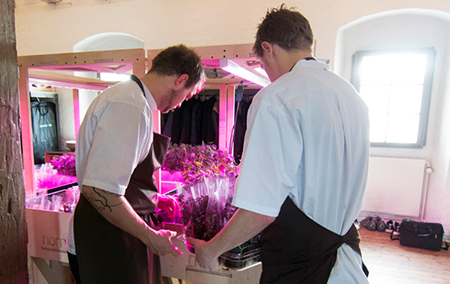
“Noma picks herbs right next to my dorm,” said Mia Kristensen.
Near the end of my visit to Copenhagen, I met Kristensen in Amager, an old working-class neighborhood near the airport that once was the city’s backwaters. Kristensen is a 25-year-old master’s degree student in food science and technology at the University of Copenhagen, a student of Frøst, the Nordic Food Lab’s director. She was also one of the first food bloggers in Denmark and runs a consulting firm called CPH Good Food, which does recipe development and food education campaigns.
Kristensen took me on a little food tour of the city. We ended up at a wine bar on the Gammel Strand, called Ved Stranden 10. It was a Monday, and quiet, and a local chef was setting up a 100 kroner ($17) one-pot meal special. The only other table was a group of men in suits who were admiring — literally oohing and ahhing — the owners’ bag of freshly foraged wild garlic. Kristensen ordered Danish white wine from the island of Lilleø.
“Danish wine?” I asked.
“It’s a very special climate on that island,” she said, quickly adding: “We don’t really have a relationship with wine in this country. We’re beer drinkers.”
After our wine — which was surprisingly pleasant, aromatic yet crisp — we wandered down to the CPH Good Food office, near the city’s culinary nerve center, Torvehallerne, the food market that just opened in Israels Plads in September 2011. “Before this, it was all flower stalls and drug addicts,” Kristensen said.
“Copenhagen is branding itself as a food city. And what’s a food city without a market?” Kristensen said. “There have been some people complaining about the food market because it was not local enough, that it’s more of a luxury market. I can see their point, but I’m just happy to have a market.”
She said that even in Denmark, the cutting-edge ideals of the New Nordic cooking are only slowly taking root among average consumers. “It takes some time to actually learn these things. It’s a whole new way of thinking. The normal consumer is trying to figure out if this is a trend or if it’s here to stay.”
Inside the CPH Good Food office, we looked at pamphlets her firm has published: Simple recipes for apple and onion breads, cauliflower dishes, soups with spelt and pumpkin. The recipes use the same sorts of ingredients as they do at Noma, but more accessible.
“You can make New Nordic into a lifestyle,” Kristensen said. “You can take your family out to pick mushrooms and berries. I know it’s a small fantasy, but in Denmark, it’s an option.”
In fact, this quaint-but-cutting-edge Denmark has always existed as a fantasy to a certain type of American like me — a place where people ride bicycles instead of cars; a place where tolerant people coexist with a commune run by weirdos and hash dealers in the middle of their clean, beautiful capital city; a place where citizens can decide, without a lot of fuss or loud, angry rhetoric, to ban unhealthful things such as junk food.
I found it inspiring that Copenhagen, which a decade ago was a culinary backwater, could transform itself into one of the most important food cities in the world. And I was inspired by the enthusiasm and idealism and — I’ll say it — the faith that a young person such as Kristensen has in changing the way her country eats, cooks and thinks about food.
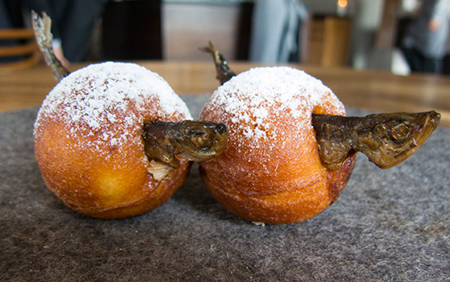
That faith became transcendent. About a month after I returned home, I was attacked by a mysterious virus, which covered the inside of my mouth with painful sores. It hurt so much that I couldn’t work. Eating caused so much pain that I traded solid food for a liquid diet for almost two weeks and lost more than 15 pounds.
As I lay in bed watching “Storage Wars,” waiting for the oxycodone to take effect and wincing down lukewarm broth or a smoothie through a straw, I was seized by the fear that I might never eat real food again.
Strangely though, as those dark thoughts entered my mind, a calmness also swept over me. Even if that bleak scenario would come to pass, and I could never eat anything ever again, I knew that it would be okay. After all, I’d always have the memory of that meal at Noma. • 9 January 2013
